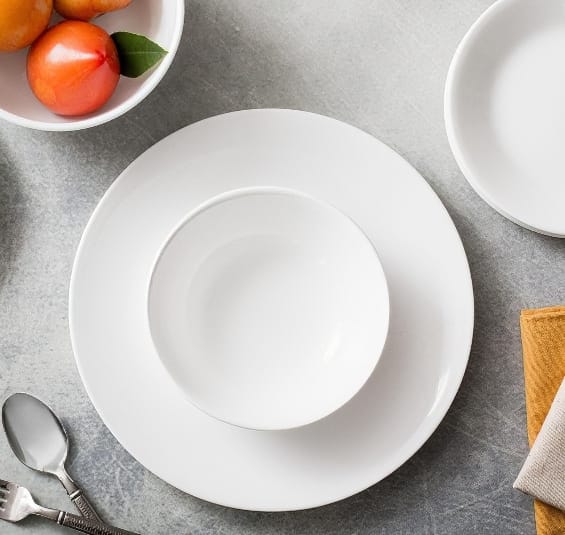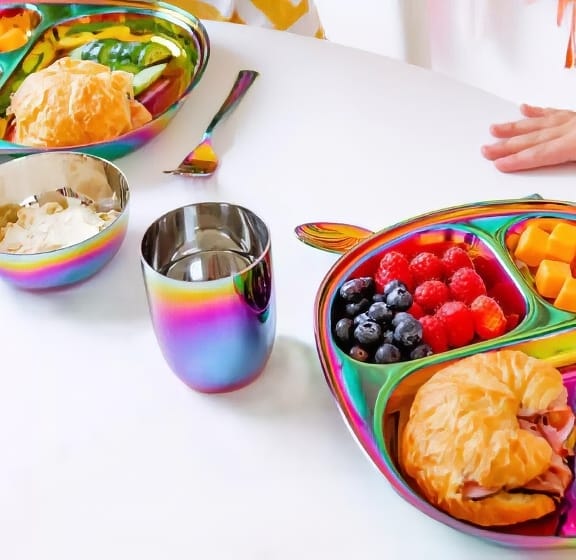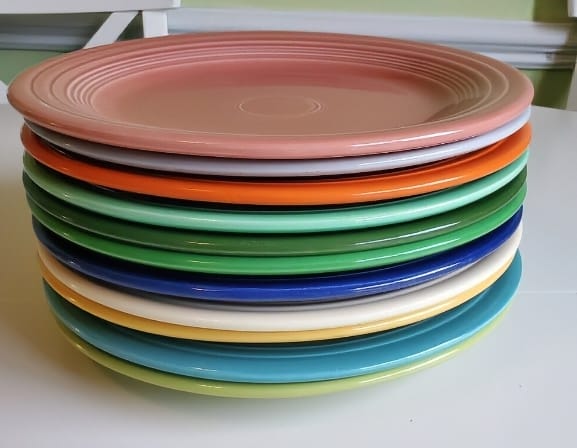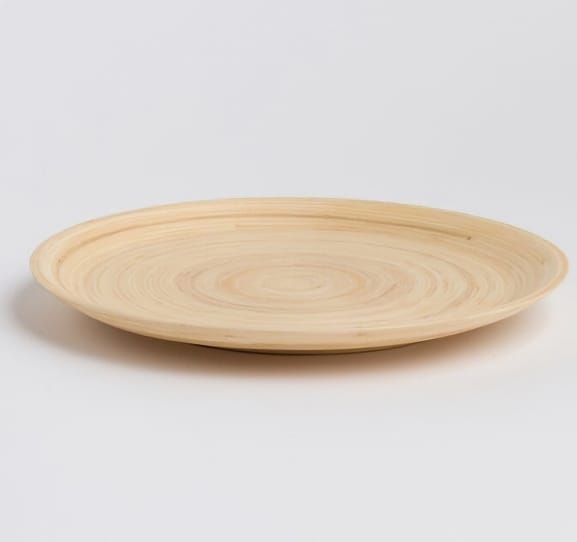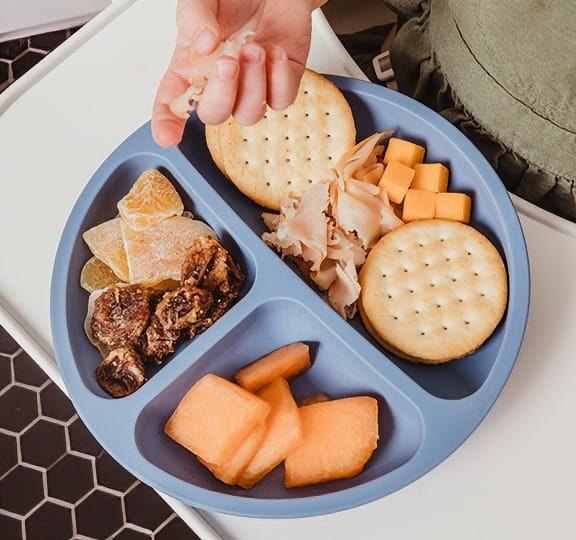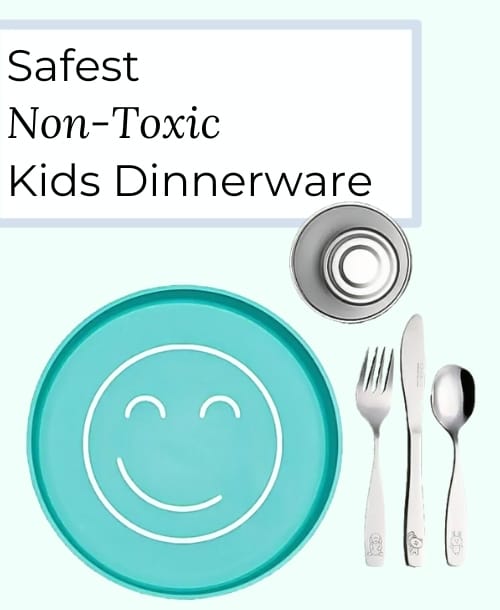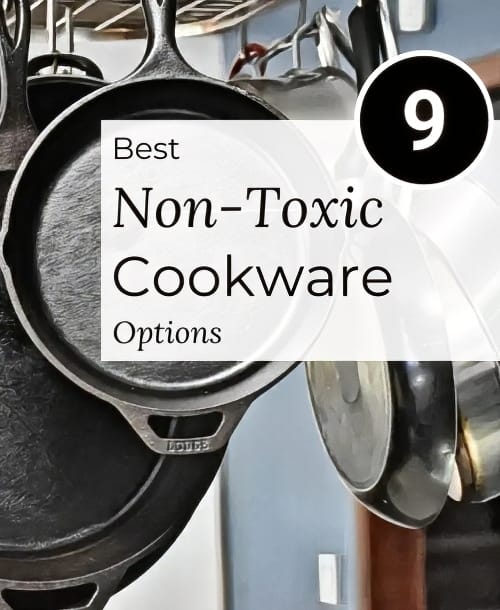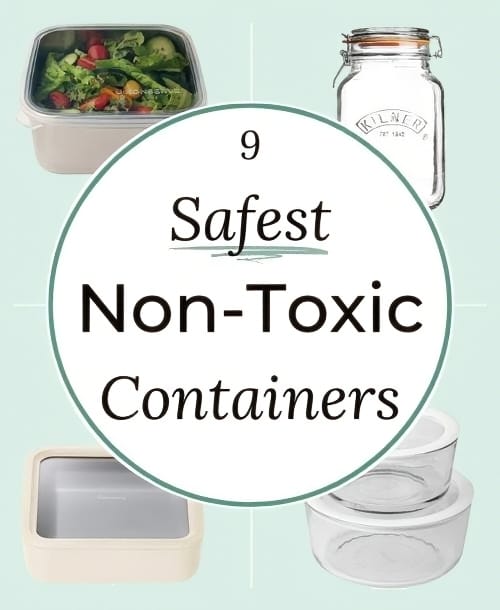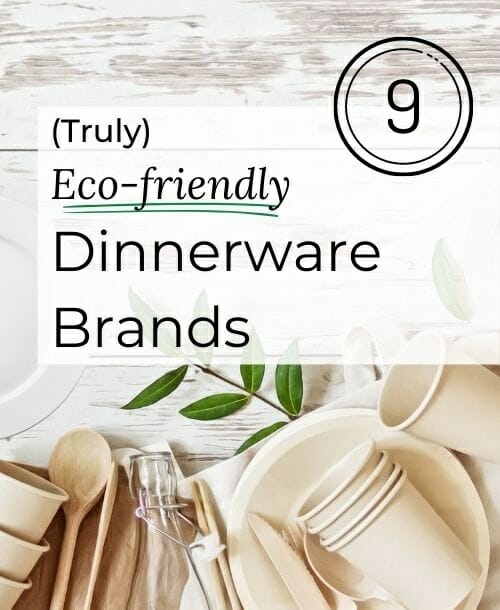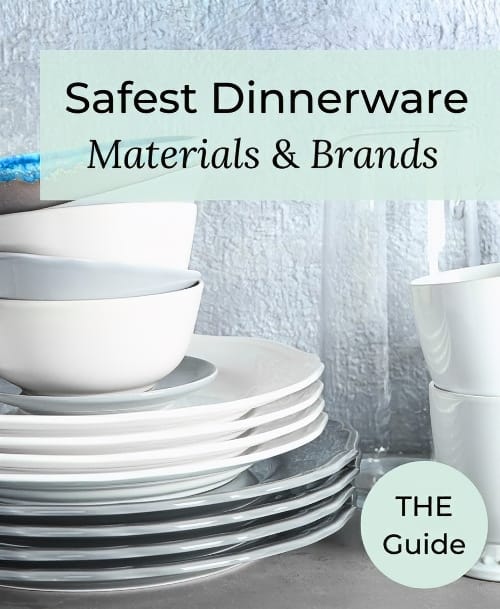
Ever wonder if your dishware is secretly harming your health? In our quest for the safest dinnerware, all the different materials can get confusing. Stainless steel, bamboo, glass, ceramics… the list goes on.
So, this guide will be your dinnerware detective. We’ll explore:
- The pros and cons of each material, including their health and environmental implications.
- The potential risks of traditional dinnerware, like chemical leaching. This includes avoiding sneaky melamine, common in most bamboo and wood dishware.
- How to choose safe options, like lead-free ceramics and good-quality stainless steel.
- Confused about those third-party labels on dinnerware? We explain what they mean.
- Tips on keeping your dishware safe and spotting unsafe plates a mile away.
And if you want to shop immediately, good news! We review the 12 best non-toxic dinnerware brands for each material (and why they’re the best).
Regardless, you’ll be well-equipped to make a safe decision by the end of this guide.
Let’s dive in!
Medically-reviewed by Dr. Ahmad Alsayes, MBBS
Common Dinnerware Risks: What to Avoid
Before we explore the healthiest dinnerware brands, let’s discuss some materials you should avoid. These can leak unhealthy chemicals into your food!
Plastic Pitfalls: Bisphenols (BPA, BPS, BPF) and Phthalates
Bisphenols (such as BPA) and phthalates are harmful chemicals often found in plastics. They can leach into food and beverages under certain conditions like heat or wear and tear.
Studies show that BPA exposure can affect the body’s natural hormone levels, leading to reproductive disorders, heart disease, and diabetes.
Here’s the kicker: even if something says “BPA-free,” it might still have BPS or BPF, which present similar health risks.
Phthalates are another culprit in the hormone disruption game. Research shows they can also lead to reproductive disorders, such as hormone-dependent cancers and infertility.
Melamine: Pretty, but Risky?
Melamine is a type of plastic that contains formaldehyde. While the FDA considers it safe under certain conditions, heat and acidic foods can leach melamine into food. That’s why they recommend keeping it out of the microwave.
Long-term melamine ingestion is linked to health concerns like high blood pressure and kidney problems. Remember that story about thousands of babies getting sick from melamine-tainted formula in China?
Also, most bamboo plates (and cutting boards) contain melamine resins to bind the thin strips together. While melamine-free options are rare, they do exist (there are a few below).
PFAS in Disposable Plates
Paper plates sometimes have PFAS coatings to resist moisture, prolonging their use. The concern lies in PFAS’s potential to leach into food.
Research links PFAS exposure to various health problems, including different types of cancer, such as prostate, kidney, testicular, and breast cancer. Environmentally, PFAS do not degrade. Instead, they accumulate, causing long-term water, soil, and living organisms contamination.
For more info on PFAS coatings, check out our Non-toxic Cookware Guide.
Lead and Cadmium in Vintage, Handcrafted, & Foreign Dishware
Lead and cadmium enhance durability and add vivid colors to ceramic dishware—lead for bright glazes and cadmium for vibrant yellows, oranges, and reds.
But, they can also leach into food through microwaving or serving hot, acidic foods on the dish.
Research shows these metals can harm the brain, kidneys, and even bones upon ingestion. To address this risk, the FDA limited lead in dishes starting in the 1970s and entirely banned it by the early 2000s.
However, older dishware might not follow these safety rules. Use caution with:
- Traditional Terra Cotta: This Mexican pottery can leach harmful metals.
- Thrift Store & Garage Sale Finds: Unknown history means unknown risk.
- Homemade and Hand-painted Ceramics: Only use them for eating if you’re confident the paint is lead-free.
- Vintage China (especially from pre-1970): Beautiful, but best for display, not dinner.
- Brightly Colored Asian Dishes: Some may contain lead or cadmium.
- Lead Crystal Glassware: Avoid due to high lead content. Reserve for display.
Stay Safe: Choose modern ceramics from reputable brands. Make sure they’re third-party tested to guarantee the absence of leachable lead and cadmium (like the options below).
For a deeper look at lead in dishware, explore our guides:
Safest Dinnerware Materials (+Pros & Cons) & Brand Picks
| Brands | Materials | Where it's Made | Price Range |
|---|---|---|---|
| Anchor Hocking | Tempered Glass: FDA & Prop 65-certified | USA | $25+ Sets |
| Corelle Vitrelle | Vitrified Glass: FDA & Prop 65-certified | USA | $55+ Sets |
| HaWare | 18/8 Stainless Steel: FDA-certified | China | $17+ Sets |
| KS&E | 18/10 Stainless Steel: FDA & CPSC-certified | South Korea | $21+ Sets |
| Ahimsa | 18/8 Stainless Steel: FDA & CPSC-certified | India | $9+ Singles - $46+ Sets |
| Fiestaware | Vitrified Ceramic: FDA & Prop 65-certified | USA | $17+ Singles - $36+ Sets |
| HF Coors | Vitrified Ceramic: FDA & Prop 65-certified | USA | $53+ Singles - $72+ Sets |
| Bibol | Organic Bamboo & Cashew Resin: Melamine-free | Vietnam | $19+ Singles |
| Bambu | Organic Bamboo: Melamine-free & CPSC-certified | China | $11+ Sets |
| OHOM Foree | Solid Acacia: Melamine-free | China | $75+ Sets |
| WeeSprout | Food-grade Silicone: FDA & LFGB-certified | China | $13+ Sets |
| Bumkins | Food-grade Silicone: FDA & LFGB-certified | China | $11+ Singles - $39+ Sets |
Glass
Pros:
- Chemical Safety: Glass is inherently safe because it does not contain harmful chemicals like lead, cadmium, BPA, or phthalates.
- Non-Reactive Surface: Glass’s inert nature protects food flavors. It doesn’t stain or leach substances.
- Versatile Style: The clear, clean look of glass dinnerware complements any decor.
- Ease of Cleaning: Glass is easy to clean and typically dishwasher-safe.
- Recyclability: 100% recyclable, glass dishware will not lose value after recycling (unlike plastic).
Cons:
- Fragility: Non-tempered glass can break or chip easily if dropped, an issue in households with children or pets.
- Temperature Sensitivity: Sudden temperature changes can crack or shatter certain types of glass.
- Weight: Glass is heavier than other materials, which might be cumbersome for daily use or when serving children.
Best Practices for Choosing Safe Glass Dishware
Due to its breakage risks, prioritize borosilicate glass over the more common soda-lime. This type of glass is more robust and can handle hot and cold food without cracking.
Tempered glass, such as Corelle’s Vitrelle line, offers the best durability against drops and temperature changes. Borosilicate can still break easily when dropped. But Vitrelle doesn’t, thanks to its three thermally bonded glass layers.
For ultimate safety, stick with plain, undecorated options. Bright colors may contain lead or cadmium unless the brand uses certified lead-free coloring.
These brands are known for their safe, high-quality glass dinnerware:
Safest Glass Dinnerware Brand Picks
Anchor Hocking makes dinnerware in the USA using thick tempered glass. Safety is a priority, so their lead-free dinnerware exceeds Prop 65’s strict safety standards.
They offer all sorts of glass dishware, from plates and cups to baking dishes and storage containers. Plus, everything is made from safe, American-made glass at a great price! For instance, their famous 12-piece set of 10-inch plates costs around $45, and you might even find it on sale for less.
Their dishes are microwave and dishwasher-safe, though not oven-safe. Overall, Anchor Hocking is a reliable choice for safe and affordable dinnerware.
Corelle’s US-made Vitrelle dinnerware stands out with its unique three-layer glass laminate. This design results in thin, lightweight, and shatterproof dishes, surpassing the durability of standard glass.
All modern Corelle is lead-safe, adhering to FDA guidelines, with third-party testing to ensure safety.
Their range of options is vast, from dinner plate and bowl sets to expansive 78-piece collections, catering to every style with various designs. Corelle Vitrelle is dishwasher, microwave, and oven-safe up to 350°F for everyday versatility.
With affordable pricing, Corelle is a top pick for durable, safe, and budget-friendly dinnerware.
Stainless Steel (18/8 & 18/10)
Pros:
- Versatile Durability: Resists dents, chips, and scratches, making it ideal for daily use (especially with children). It’s also great for outdoor dining – I use mine for camping!
- Corrosion Resistance: Stainless steel resists rust and corrosion, maintaining its good looks over time.
- Health and Safety: Its non-toxic, inert surface never leaches chemicals into food (except trace amounts of nickel and chromium under certain conditions, which generally cause no health concerns).
- Easy Maintenance: Stainless steel’s rust-proof and non-porous nature makes it dishwasher-safe and easy to sanitize. It doesn’t harbor bacteria or odors.
- Sustainable: Steel is infinitely recyclable, so it can return to its original use without losing quality. Plus, its durability means fewer replacements.
Cons:
- Heat Conductivity: Steel dishware can get hot when holding warm foods, making it a safety concern.
- No Microwave Use: Not ideal for reheating leftovers (unless you use your oven).
- Water Spots: Steel dishware requires prompt drying to prevent water spots. Choose matte polished stainless steel to limit these blemishes.
- Nickel and Chromium-Leaching: Serving hot, acidic foods on steel plates can leach nickel and chromium into food. Those with allergies should look elsewhere or choose nickel-free 18/0 steel.
Best Practices for Choosing Safe Stainless Steel Dinnerware
Not all stainless steel is created equal!
Look for 18/8 or 18/10 stainless steel on the label. These grades resist rust better, which is essential to keeping your food safe. Some cheap options use lower-quality steel (like 201-grade), which can rust easily. I learned that the hard way in my early product sourcing days.
Also, avoid brands that don’t tell you what type of steel they use. If it just says “stainless steel,” it’s probably not the best quality.
Stick with plain dishes whenever possible. If you love colorful options, make sure the paint is certified lead-free.
Safest Stainless Steel Brand Picks
HaWare’s 18/8 stainless steel dinnerware resists rust and never leaches chemicals into your food. Not only that, but their plate’s smooth, rounded edge design and matte polishing make them comfortable and easy to clean for daily use.
These plates can’t go in the microwave, but they’ll move easily between the dishwasher and oven – just be careful, they can get hot!
HaWare offers 8-inch and 10-inch plates, all in 18/8 stainless steel. They also provide 18/10 silverware for an ultimate corrosion-resistant combo.
Despite its high-quality, rugged design, HaWare is affordable. Their 6-piece set of 10” plates costs $25, making them accessible to many.
KS&E brings you top-notch dinnerware made from Korean 18/10 stainless steel. This super rust-resistant steel keeps your plates safe and hygienic for a long time.
They get bonus points for safety, with FDA and CPSC certification confirmed through third-party testing in London, UK.
You can choose from standard dinner plates, bowls, and various divided plate designs – perfect for picky eaters or portion control. Just remember, no microwaving! They’re dishwasher-safe, but use oven mitts if you heat them in the oven.
Lastly, most KS&E sets cost less than $30, so you get quality without breaking the bank!
Ahimsa is shaking things up with their Indian-made, rainbow stainless steel dinnerware! Unlike typical color applications, Ahimsa uses a safe titanium vapor process. The inert, non-toxic titanium interacts with the steel to create vibrant shades that won’t chip, peel, or leak chemicals.
Ahimsa’s priority is safety, so independent companies test their dishes to meet strict FDA and CPSC standards.
They have many options, from plates and bowls to cutlery and drinkware. All options come in rainbow, blue, or plain 18/8 stainless steel designs.
Ahimsa plates are a bit more expensive due to their advanced manufacturing, but you’re getting top quality, safety, and a unique aesthetic appeal.
Lead- & Cadmium-Free Ceramic/ Porcelain
Pros:
- Versatility in Design: Ceramic and porcelain come in many options, from simple white dishes to intricate, colorful designs. They can suit both casual and formal settings.
- Durability: High-quality porcelain and vitrified ceramics are known for their strength and chip resistance, making them durable for daily use.
- Heat Retention: Both are excellent at retaining heat and keeping food warmer for longer when serving.
- Inert and Non-Porous Surface: The glazed surfaces resist stains and odors, making them easy to clean and hygienic. Neither reacts with acidic foods nor alters flavors.
Cons:
- Vulnerability to Cracking and Chipping: Ceramics can chip and crack if not handled carefully, and porcelain can be costly to replace.
- Weight: Heavier than alternatives like bamboo or silicone, making handling and storage more challenging.
- Potential for Lead and Cadmium: Lower quality or older ceramic and porcelain products may contain lead or cadmium glazes. Bright red, orange, and yellow designs are more likely to use these metals.
- Not Always Microwave and Oven-Safe: Not every ceramic and porcelain dish is safe for microwave or oven use (i.e., crystal and some handmade pottery). Always check the manufacturer’s guidance to avoid damage or safety hazards.
Best Practices for Choosing Safe Ceramic and Porcelain
When it comes to ceramic or porcelain plates, going with a trusted brand is vital.
Reputable companies are more likely to use safe glazes and have strict checks in place to keep nasty chemicals out of your food.
Always check the label or description for words like “lead-free” or “cadmium-free.” Look for FDA or Proposition 65 certifications for lead safety.
Also, note that most places do not recycle porcelain or ceramic. So, if you’re environmentally conscious, check for brands using eco-friendly practices. These include sustainable sourcing of materials or energy-efficient manufacturing.
Lastly, it’s important to protect your ceramic’s glaze to guarantee safety. Use protector pads when stacking plates and limit excessive dishwasher use.
Safest Ceramic and Porcelain Brand Picks
Fiestaware is famous for its colorful, industrial-strength ceramic dishes made in the USA. They put safety first. Since 1986, all their dishware is lead- and cadmium-free, exceeding FDA and Prop 65 safety standards.
These thick, chip-resistant plates can handle everyday use and have a 5-year warranty to prove it. But Fiestaware isn’t just tough; it’s also versatile…
You can freeze it, toss it in the dishwasher, microwave, and even the oven up to 500°F. And it comes in over nine fun colors (lead-free), with various sets and serving platters available.
Although pricier than generic ceramic options, Fiestaware’s mid-range cost is fair for the quality and longevity you get. It’s accessible to most, though something like Corelle could better suit tighter budgets.
Like Fiestaware, HF Coors makes high-strength vitrified ceramic dishes in the USA.
They skip the lead in their clay and glazes, and any tiny amount of cadmium is locked inside the dish, so it can’t get into your food. To prove this, they tested their old plates with worn-out glazes. Not a sliver of heavy metals were detected, exceeding Prop 65 and FDA standards.
But what sets HF Coors apart from Fiestaware? Two things: their unmatched durability and unique design variety.
Their dinnerware is dishwasher, microwave, oven, and even broiler-safe with no temperature limit. Also, HF Coors offers beautiful American Indian-inspired patterns you won’t find anywhere else.
These features come at a price, but you’re getting safe, American-made dishes built to last. If you’re extra worried about cadmium, choose their plain white dinnerware.
Melamine-Free Bamboo
Pros:
- Eco-Friendly: Bamboo grows fast, making it a renewable, sustainable choice.
- Light but Tough: Bamboo plates are easy to hold yet surprisingly hard to crack or chip compared to traditional materials.
- Naturally Antibacterial: Bamboo has natural antibacterial traits, offering an added layer of hygiene.
- Stylish: Offers a natural, earthy vibe.
- Knife-Friendly: Bamboo is softer than metal or glass, so it won’t dull your knives.
Cons:
- More Care Required: Unlike some materials, bamboo plates can warp or crack if not cared for properly. Wash them by hand and skip the microwave, oven, and dishwasher.
- Beware of Chemicals: Some bamboo dishes use glues to hold their shape. If the plate gets hot, these glues might leak chemicals, so look for melamine-free options.
Best Practices for Choosing Safe Bamboo Dinnerware
Choose bamboo plates from trusted brands that skip the melamine and use natural dyes. To be safe, check for FDA certifications and “melamine-free” labels. Also, make sure any colors or designs are certified lead-free.
Also, it’s vital to properly maintain bamboo dinnerware (especially all-natural, melamine-free options). Avoid prolonged soaking, which can undo the bamboo fibers. Wash by hand and dry thoroughly. Rub them down with some non-toxic oils occasionally.
Safest Bamboo Brand Picks
Bibol takes bamboo dinnerware to a whole new level! Their handcrafted plates and bowls are made in Vietnam from leftover bamboo trimmings.
They skip the glues and use a natural resin from cashew trees to hold everything together. Some pieces even get a splash of color with a safe marble powder lacquer.
The downside? Because they’re handmade and delicate, you can’t stick them in the dishwasher, microwave, or oven.
But the upside? You get 100% natural dinnerware free of lead, cadmium, melamine, glues, and other nasties. It’s a bit of a splurge, but if you love unique, safe dishes, Bibol might be perfect for you.
This brand offers a non-toxic, eco-friendly disposable dinnerware option free from melamine, lead, cadmium, and PFAS linings (used in some paper plates).
Instead, this brand uses 100% organic, responsibly sourced bamboo with water-based adhesives to shape each item. While costing more than paper plates, they’re sturdier and more eco-friendly. Upon disposal, they naturally degrade into the earth in 4-6 months, earning a USDA-Certified Biobased label.
The one tradeoff is that you can’t put these in the microwave as it can heavily warp the bamboo. But for serving hot food, these are perfect. Whether used for easy-cleanup dinners or large parties, there’s an option available with various plate and cutlery sets available.
Read more in our Guide to Melamine-Free Bamboo Plates.
Natural, Unglued Wood
Pros:
- Sustainable: Wood is a natural resource that grows back. When sourced responsibly, it’s a sustainable choice.
- Looks Great on the Table: Wood plates add a warm, natural touch to your meals.
- Safe for everyday use: High-quality wood plates are free of harmful chemicals.
- Durability: When you take care of them, wood plates can resist chips and cracks better than ceramic or glass options.
Cons:
- More Care Required: Wood demands hand washing, drying, and periodic oiling to prevent drying out and cracking.
- Not Dishwasher or Microwave Safe: The high heat can warp and split wood, making it less convenient than traditional materials.
- Can Be Finicky: Some wood plates stain or absorb odors more easily if not sealed well. Others might have rough edges that need sanding.
- Potential for Chemical Additives: Like bamboo, some wooden plates use melamine glues to hold them together. These chemicals can leach when heated.
Best Practices for Choosing Safe Wood Dinnerware
Opt for dishes shaped from a single piece of wood. This avoids glued options with weak spots or potential chemical leaching.
Look for natural finishes, such as beeswax or organic coconut oil. This ensures no petroleum-based chemicals get into your food.
Check for labels like “melamine-free” or “one-piece” for safety. Avoid colorful wooden plates unless they have lead-free certification.
Also, consider the wood type and source. Choose sustainably sourced hardwoods like maple, teak, and acacia for their durability and moisture resistance. Look for FSC-certified labels to ensure responsible harvesting.
Safest Wooden Dishware Brand Pick
OHOM’s Foree collection stands apart in the wooden dinnerware arena. Unlike most, it shuns the use of chemically bound wood strips.
Each dish is hand-carved from a solid piece of acacia, kind of like an ancient dugout canoe! This unique method gives each plate an oblong shape and distinctive grain. The charm is undeniable.
Foree offers plates, bowls, serving platters, and complete dinnerware sets. Just remember, wood plates need special care – no dishwashers or microwaves for these!
Price-wise, Foree falls in the middle ground. They’re similar in cost to HF Coors ceramic dishes, so you get a nice balance of quality and affordability.
Food-Grade Silicone
Pros:
- Non-Toxic: Food-grade silicone is free of BPA, lead, and phthalates. It’s also inert, which doesn’t react with acidic foods like plastics.
- Handles Heat Like a Champ: Silicone’s heat resistance (up to 446°F) withstands hot food and microwaves without melting or leaching.
- Durability: Silicone is flexible and tough, never chipping or shattering. Its softer, child-friendly texture won’t damage floors if dropped.
- Easy to Clean: Silicone is naturally non-stick, making it easy to clean and less likely to harbor bacteria. It’s dishwasher-safe, too!
- Lots of Fun Options: Silicone comes in various colors and designs, perfect for picky eaters or matching your kitchen decor.
Cons:
- Bendy Plates = Potential Spills: Silicone plates can bend under heavy foods, which might lead to spills.
- Stinky Food Syndrome: All silicone can sometimes absorb odors from dish soap or strong-smelling foods. Need to remove a smell or stain (or that occasional oily film)? Boil your silicone for 15 minutes.
- Quality Matters: Not all silicone is equal; some cheap options may contain hidden chemicals. So ensure you’re getting food-grade, FDA-certified silicone.
- Not Exactly Eco-friendly: Silicone isn’t biodegradable, and not many places recycle it. That said, its durability can reduce the need for frequent replacements.
Best Practices for Choosing Safe Silicone Dinnerware
To avoid buying unsafe, low-quality silicone, look for “food-grade” labels and FDA certifications. This ensures it meets safety standards and won’t leach chemicals into your food. If you can find it, LFGB is the top-of-the-line safety certification.
High heat can damage silicone, so don’t put it directly on the stove or under the broiler. Check your item’s care instructions for temperature limits.
Lastly, look for companies known for using high-quality, food-grade silicone. This ensures both the safety and longevity of your dinnerware. Here are some brands that meet these criteria:
Safest Silicone Brand Picks
WeeSprout’s non-suction plates aren’t just for kids. Made from 100% pure, FDA-certified silicone; these dishes are third-party tested and guaranteed lead-free. Vibrant colors come from natural, food-safe vegetable dyes.
Between silicone’s safety and microwave/ dishwasher compatibility, it’s hard to beat its versatility. As a bonus, the plates have some grip to help prevent spills.
WeeSprout offers a range of silicone dishes, bowls, cups, and even food storage containers, all plastic-free. Their matte-colored plate set is an excellent option for any age.
With affordable pricing (most sets under $20), WeeSprout provides top-notch quality at a good value.
This brand shines for non-toxic kids’ dinnerware. Their silicone suction dishes are among the most effective I’ve tested.
Made entirely from third-party tested, FDA and CPSIA-certified silicone, these dishes are free of harmful chemicals.
On the bottom of each dish sits a powerful suction base to prevent spills. And they come in tons of colors, along with drinkware, cutlery, and more – all 100% plastic-free. All of their items are microwave, oven (up to 400℉), and dishwasher-safe for easy cleanup.
At $11 a plate, Bumkins is affordable, too, despite its high-quality design.
See our Non-Toxic Kids Dinnerware Guide for more on silicone and other plastic-free kids’ plates.
How to Identify & Choose the Safest Dishware
Here’s a step-by-step guide for evaluating and choosing safe dinnerware:
1. Check Certifications: Check for FDA or Proposition 65 certifications. With these labels, the product must meet safety guidelines and warn you about potentially harmful chemicals used.
2. Check Manufacturer Claims: Trusted brands advertise their dishware as “lead-free” or “3rd-party tested.” Visit their website or call them to see what safety standards they follow. For ceramic or porcelain, make sure the glaze is safe for food. It should say “lead-free” or at least “lead-safe.”
3. Visual Inspection: High-quality, smooth glazes (without cracks or irregularities) are less likely to leach lead.
4. Lead Test Kit (optional): Want extra peace of mind? Hardware stores (and Amazon) sell lead test kits to check your plates for leachable lead.
5. Know Your History: Older dinnerware is more likely to leach lead. If you love vintage stuff, research when it was made to get a safety clue. Remember, the FDA only began regulating lead in the 1970s.
6. Recalls and Safety Warnings: Check if the brand has ever had product recalls or safety warnings. One example is Corelle’s pre-2000 dishware, covered in our Corelle safety guide.
7. Check Where it’s Made: Manufacturing standards differ by country. Unknown, Chinese-made ceramics might be riskier than plates from trusted U.S. or European brands.
8. Knowing a Product’s Limitations: Plates wear out, affecting safety. For example, wood or bamboo plates can break down or grow hazardous mold if not cared for properly. Glazed ceramics can leach metals if heavily scratched.
9. Simple is Safer: Simpler designs (such as solid white plates) are often safer than those decorated with bright glazes or hand-painted designs. These decorations can sometimes contain lead or cadmium.
10. Prefer Known Safe Materials: Glass, stainless steel, silicone, natural wood, and melamine-free bamboo are all good choices. Plates made from these materials generally avoid lead concerns.
Time-Saving Tip: To quickly find product safety details online, use your Control+F (Command+F on Mac) keyboard shortcut:
- Type in the buzzwords you’re looking for, such as “lead,” “FDA,” “melamine.” etc. You’ll be able to jump straight to that wording on the page.
Maintaining Your Dinnerware to Prevent Damage & Reduce Toxin Exposure
Here’s how to maintain your dinnerware’s integrity to keep it safe and prevent damage and mold risks.
Cleaning & Storing Tips by Material:
Glass: Warm water and mild soap are all you need for everyday cleaning. For stubborn stains, use a vinegar and water mix, then rinse well. Skip the rough sponges – they can scratch the glass.
Stainless Steel: Clean with a soft sponge and mild soap to prevent micro-scratches (which can harbor rust). Baking soda paste works well for stuck-on messes. Dry your stainless steel right away to prevent water spots.
Ceramic and Porcelain: Use a soft sponge or brush with mild soap for everyday cleaning. Hand-washing is gentler than the dishwasher and helps prevent chips and glaze wear. Stack plates with a soft cloth in between to avoid scratching the glaze. Baking soda soak helps remove tea or coffee stains.
Bamboo and Wood: Wash with warm, soapy water and a soft sponge or brush. Dry them right away – no soaking! Treat them with food-safe oil every month to prevent cracks. Skip the microwave and dishwasher – high heat can cause warping or cracking. Store them in a cool, dry, and airy spot to avoid mold.
Silicone: You can put silicone in the dishwasher, but hand-washing with warm, soapy water extends its lifespan. Avoid sharp utensils that can slice the silicone deeply. To rid harsh smells or stains, boil your silicone in water for 10-15 minutes.
How to Prevent Lead & Cadmium Leaching from Dinnerware:
- Avoid chipped or cracked glazes: Those cracks can let metals seep into your food. So, toss any damaged plates.
- Microwave with caution: Heat can make heavy metals and chemicals leach faster. Check the manufacturer’s instructions – some plates aren’t microwave-safe. Never microwave dishware with metallic designs.
- Easy on the acid with certain plates: Acidic foods like tomatoes or oranges can make some unglazed or scratched ceramics leach lead. It’s best to use different plates for those.
- Limit dishwasher use: Too many washes can wear down the glaze on ceramic plates. A worn glaze might leach lead the next time you use it. In some cases, lead also contaminates other plates in the dishwasher.
- Follow the rules: Always check the manufacturer’s guidelines on temperature limits and best cleaning practices.
When to Replace Your Dinnerware: Signs of Wear that Could Compromise Safety:
- Glass: Cracks or chips? Toss them! These spots can harbor bacteria. Also, cloudy glass after cleaning could indicate it’s time for a replacement.
- Stainless Steel: Rust signals that the steel’s integrity is breaking down, which could leach nickel or chromium into food. Also, look out for tiny pits in the steel, which indicate wear.
- Ceramic and Porcelain: Cracked glaze? Time to ditch it! Cracks can trap bacteria and may also let lead or cadmium seep into your food (if present in the glaze). Another sign? If you see a dusty, gray residue on your towel after drying, that plate must go.
- Bamboo and Wood: Cracks or splits are a no-go – they can harbor bacteria and mold. Also, look for discoloration, a change in texture, or weird smells after cleaning. This indicates deep-seated mold or bacterial growth.
- Silicone: Deep cuts are bad—bacteria love hiding in them. If your silicone feels sticky, it’s breaking down, and it’s time for a new one.
Frequently Asked Questions
Is Corelle dinnerware non-toxic?
Yep! Modern Corelle plates are lead-free and safe for everyday use. But, heads up, plates made before 2000 might have lead. Stick to newer ones to be on the safe side. Check out our Corelle Safety Guide for more info on unsafe patterns and years.
Are dishes made in China safe to use?
It depends. Safety rules in China can differ from those in the U.S. or Europe. Before buying the plates, ensure they are third-party tested and meet U.S. safety guidelines (FDA or Prop 65).
Is bone china toxic-free?
Bone china is generally safe. It’s made from bone ash, clay, and other natural materials, fired at super high temperatures to rid impurities. However, older or decorated bone china might contain lead or cadmium. So, look for new, certified lead-free options to be extra careful.
Do Pfaltzgraff dishes contain lead?
Pfaltzgraff says their dishes are lead-safe and follow U.S. safety regulations, meeting FDA standards. Older pieces might contain lead, but current production is lead-free. Still, always check recent certifications and production years to be sure.
Do Ikea plates have lead?
Nope! Since 2010, Ikea has produced its dinnerware without lead, meeting strict safety standards.
Recap & Conclusion
Picking the safest dishes to use can seem confusing, but it doesn’t have to be! Safe materials make for delicious and worry-free meals.
Here are the actionable takeaways to ensure your dinnerware is safe, sustainable, and suited to your lifestyle:
- Opt for 18/8 or 18/10 stainless steel: This super strong steel resists rust and lasts forever. It’s easy to clean and safe for everyday use.
- Select modern ceramics and porcelain (third-party tested): Look for plates tested for safety, especially bright or decorated options. Make sure they’re lead-free and cadmium-free.
- Prioritize melamine-free bamboo and wood: Choose one-piece options (unglued) or those using safe, water-based adhesives (not chemicals).
- Choose tempered glass: This glass is less likely to break or develop bacteria-breeding scratches. The above options (like Corelle’s Vitrelle) offer superior durability and hygiene.
- Pick food-grade, certified silicone: Ensure your silicone dinnerware is certified by the FDA or LFGB. It’s safe, flexible, and heat-resistant, perfect for adults and kids alike.
Remember, the safest dinnerware aligns with rigorous safety standards, embodies sustainability, and fits your family’s lifestyle.
P.S. Healthy dinnerware is just one part of the equation. Food storage containers, pots and pans, and bakeware can also leach chemicals. Look into those next to make your kitchen completely safe!

Hi there! I'm Adam, author and founder of TGL. Since 2016, I've produced and sold non-toxic kitchenware throughout the US. Today, I'm using my passion and experience in sustainable product manufacturing to help families avoid unsafe reusable foodware. When I'm not writing, you'll find me hiking or camping throughout Appalachia!
Enjoyed this post? Share it with your friends!
Related Posts


